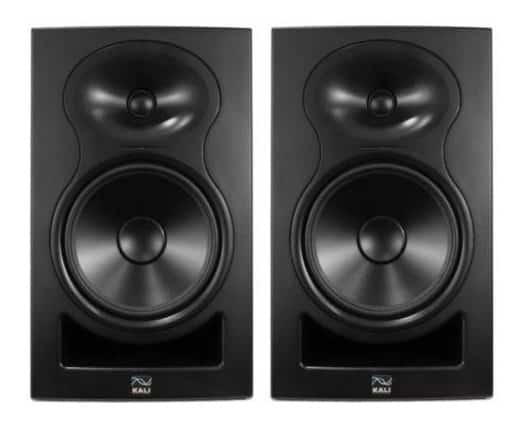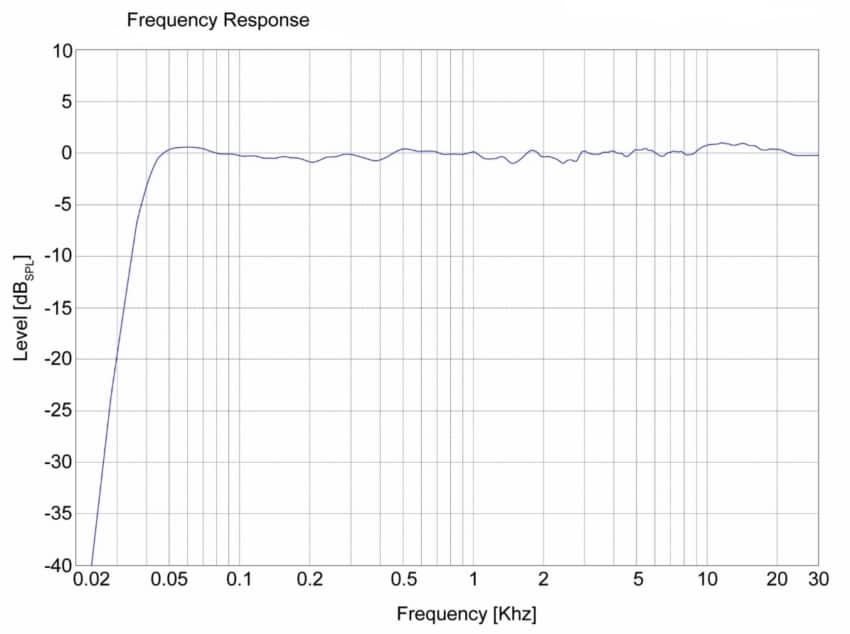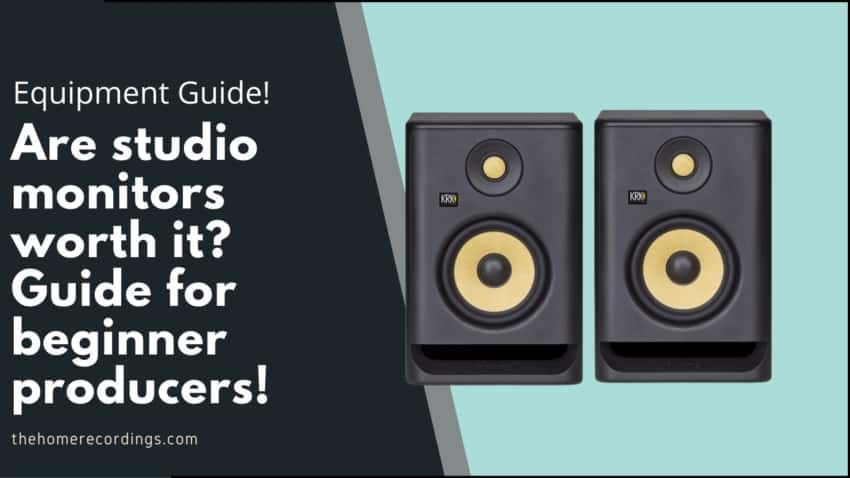Last updated on December 31st, 2023 at 06:00 pm
Studio monitors are an integral part of every professional-, and even home studio, but why is this? Are they really worth buying? Even for people who are only interested in music production as a hobby?
Even though I think that you can get started on any set of regular speakers, or even headphones, at some point you should upgrade to a pair of studio monitors since these will allow you to produce music better. However, why is this?
I will be answering all of these questions in this article!
So, without any further ado, let’s get started!
Are studio monitors worth getting?
Studio monitors are worth getting mostly for anyone interested in music production since they have a higher than average audio quality, a flat frequency response, which doesn’t color the sound in any way, and they reproduce audio cleanly without distorting it.
Of course, this is the short version, but there’s more to the story. So, stick around to find out why you may, or may not, want to get yourself a pair of studio monitors.
Let’s first start by asking:
What are studio monitors?

Studio monitors are loudspeakers specifically designed for professional audio production applications, such as recording studios, filmmaking, television studios, radio studios and project or home studios, where accurate audio reproduction is crucial, and they are used for “critical listening”.
Generally, studio monitors are designed to sound as flat as possible, or to have a flat frequency response, where there’s no extra EQ cutting or boosting specific frequencies to make them sound better, but rather to help them reproduce audio as accurately as possible since you need to be able to hear what is going on in the mix.
Studio monitors are also Close-field, or Near-field speakers, which means that they are small enough to sit on a stand or desk in proximity to the listener, so that most of the sound that the listener hears is coming directly from the speakers, rather than reflecting off of walls and ceiling (and thus picking up coloration and reverberation from the room).
In short; Studio monitors are designed with accurate audio reproduction in mind, where no frequencies are boosted or attenuated on purpose to color the sound, or to make them sound better, which is why they are often referred to as “flat-sounding” and why they are used in anything audio-related.
If you’re thinking of getting your first set of studio monitors, then make sure to check out this article I wrote about the best studio monitors under $300.
They have a flat frequency response

Sounding “flat”, or having a flat frequency response, just means that there are no specific frequencies being cut or boosted to make the music sound “better”, “punchier”, etc., which is something that you can find a lot today on commercial headphones, for example, where the bass is being boosted quite a bit.
My Hi-Fi system also does this and, in all fairness, the way it sounds is much more interesting and appealing to me, but it’s not the best system for mixing since it’s not representative of how the different instruments actually sound in the mix, plus you may not be able to discern if some frequencies are being boosted too much or if they are being masked by other frequencies, making the mixing process a lot more difficult.
Studio Monitors tell you what is going on in the mix
Not only are studio monitors designed to sound as flat as possible, meaning that you’ll be hearing the most accurate representation of how the audio actually sounds in your DAW, but they are also designed to reproduce all frequencies with as much detail as possible.
This means that you’ll be able to much better gauge what needs to be adjusted while mixing and producing music since studio monitors provide you with the best picture possible.
There are some speakers out there which actually don’t sound that flat, but rather exacerbate a problematic area/frequency spectrum, which lets you hone in on those frequencies far more easily.
An example of this kind of speaker are the NS-10’s by Yamaha which exaggerate the mids, sounding completely unnatural but also allowing you to properly separate instruments that live in that frequency spectrum, such as the guitar, vocals, etc.
It’s also worth mentioning that there’s not a “one size fits all” kind of monitor, and that’s why most studios use different sets of them during the mixing process to address different issues.
Studio Monitors don’t distort the audio

One of the cons of regular speakers is that they distort audio, although very slightly, once they exceed a certain volume threshold, and this is far from ideal for music production, mixing and mastering.
Now, even though studio monitors are definitely not meant for reproducing music at really high levels, they can generally be pushed to their limits without distorting since, again, they are used to listen to music critically to gauge whether or not something needs to be adjusted.
Audio Crossover/Crossfeed (when compared to headphones)
Even though you could certainly mix most of your music only on headphones, there’s one critical aspect that you only get when doing so on speakers; Audio Crossover.
Audio Crossover simply means that your right and left ears will be receiving information from both speakers simultaneously, whereas with headphones all the information on the right channel goes to your right ear and all the info on the left channel goes to your left ear.
As you can imagine, this can lead to a number of problems, such as not being able to detect phase issues, not getting a proper feel of the stereo image, and more.
Improved Dynamic Range
Dynamic range is the difference between the softest and loudest signals a device can handle, in this case audio intensity (measured in dB), and speakers that have a wider dynamic range will be able to reproduce louder and quieter sounds more accurately than ones that have a lower dynamic range, which, again, is crucial for music production.
How much do you need to spend to get quality studio monitors?
Of course, here the sky is the limit, since you can get studio monitors that cost about 10k for just one speaker, not the pair, and if there’s one thing that I’d recommend investing in, it’s studio monitors.
Studio monitors are your ears in music production and they allow you to detect and correct issues, balance frequencies, and create a great product, which is why I think that the majority of your budget should go towards high-quality studio monitors.
That being said, there are more and more monitors being produced on the budget side of thing (about $300 for the pair) that are performing really well and that allow you to get your foot into the whole recording scene without having to put a mortgage on your home.
On the cheaper side, you will be spending about $300 for a pair of studio monitors, while if you’re looking for something more high-end, you may have to spend somewhere around $1400 for a pair.
Here are the ones that I’d recommend getting:
Studio Monitor Recommendations for every budget
For most people, who I assume as beginners or just enthusiasts who like to produce music every now and then, I’d recommend going with something affordable. Just make sure that they are decent speakers and not the ones being marketed as “Studio Monitors” when, in fact, they sound like garbage! Yes, I’m looking at you PreSonus Eris e3.5 and e4.5.
In this case I have two recommendations:
- Kali LP-6 (Get these if you can): Amazon, Sweetwater.
- Adam Audio TV5: Amazon, Sweetwater.
I tried both and, in fact, I own a pair of the Kali LP-6, and they sound great and only cost about $300 a pair.
For people looking to up their game, I’d recommend these:
- Yamaha HS8: Amazon, Sweetwater.
Conclusion
To make music production easier, studio monitors should definitely be used! Of course, checking how everything sounds on different systems is an absolute must, which is why people tend to gauge how well a piece of music was produced by listening to it in the car… If it sounds great in a car, it sounds fantastic everywhere else.
Having said that, if you own a pair of respectable Hi-Fi speakers and are just starting out, don’t spend money on studio monitors, especially because you should be getting somewhat decent ones and those aren’t that affordable!
F.A.Q.s
Can you mix on regular speakers? While mixing on regular speakers isn’t ideal because they color and enhance the sound, making it more difficult to listen to a piece of audio critically, if you know exactly how audio should sound through those speakers, you should be able to mix on them, at least in the beginning.
Can you mix on only headphones? Mixing a song, or most of it at least, on headphones is definitely doable as long as you understand the drawbacks of doing so, like not being able to detect some phase problems. Generally, referencing on at least a pair of regular speakers is advised.
